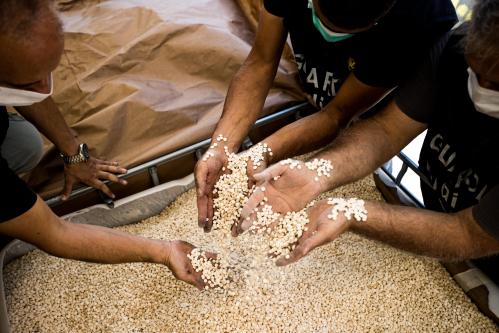The Islamic State claims to have reestablished a caliphate in accordance with the prophetic method, misleading at least one historian, Edward Luttwak, to conclude that the Islamic State only seeks “its inspiration from the first four caliphates” that followed Muhammad. According to Luttwak, not even the mightiest of the caliphates that followed, the Abbasid caliphate, is a model for the Islamic State.
But take a look at the Islamic State’s propaganda, and you will see that from its founding the group has sought to restore the glory days of the Abbasid caliphate based in Baghdad, especially the era of Harun al-Rashid of 1,001 Nights fame.[1] “Know that the Baghdad of al-Rashid is the home of the caliphate that our ancestors built,” proclaimed an Islamic State spokesman in 2007. “It will not appear by our hands but by our carcasses and skulls. We will once again plant the flag of monotheism, the flag of the Islamic State, in it.”[2]
That same year, the Islamic State’s first ruler, the aptly-named Abu Umar al-Baghdadi announced IS’s claim to the city: “Today, we are in the very home of the caliphate, the Baghdad of al-Rashid.”[3] Even after the Islamic State established its primary base of operations in Syria’s Raqqa province, once home to Harun al-Rashid for several years, and captured Mosul in Iraq, its spokesman still referred to “the Baghdad of the Caliphate” and “the Baghdad of al-Rashid.”[4]
The Islamic State’s plan to revive the Abbasid caliphate in Baghdad has two problems. The first is ideological: Harun al-Rashid was not terribly pious—he enjoyed poetry about wine and young boys—and his court valued unfettered intellectual debate and pagan Greek learning, which are anathema to ultraconservative Salafis like those running the Islamic State. But it is al-Rashid’s power the jihadists remember, not his impieties.
The second problem is demographic, which cannot be resolved by selective memory: most of Baghdad’s inhabitants are Shi’a. They will not give it up without a fight. Neither will Baghdad’s patrons in Iran.
Given that, outsiders might reasonably conclude the Islamic State is foolish to aim for Baghdad rather than consolidate its gains in the Sunni-majority areas it now holds. But sometimes historical imperatives override strategic ones.
[1] The phrase “al-Rashid” is not a common epithet for Baghdad in medieval books of Islamic history. When the phrase is used, it usually refers to events in the city of al-Rashid’s own day. See for example, al-Yafi`i’s “Mirat al-Jinan,” [“وفي السنة المذكورة توفي قاضي بغداد الرشيد أبو عبدالله سعيد بن عبد الرحمن الجمحي المدني”]. In modern discourse, the phrase “the Baghdad of al-Rashid” is sometimes contrasted with “the Damascus of al-Walid,” one of the great Umayyad caliphs that ruled from the city. The Islamist Hakim al-Mutayri, for example, tweeted “The battle today into which have plunged the Baghdad of al-Rashid and the Damascus of al-Walid represents the entire Muslim community.”
[2] Muharib al-Jaburi, “al-`Ilan `an qiyam dawlat al-`Iraq al-Islamiyya,” 15 January 2007.
[3] Abu Umar al-Baghdadi, “Wa-yamkurun wa-yamkur Allah,” 15 September 2007.
[4] Abu Muhammad al-Adnani, “Al-Iqtihamat afja`,” Noevember 2012; “Lan-yadurrukum illa adha,” February 2013; “Al-Ra’id la yakdhab ahlaha,” January 2014; “Ma asabaka min husna fa-min Allah,” 11 June 2014.



Commentary
Why ISIS Really Wants to Conquer Baghdad
November 12, 2014